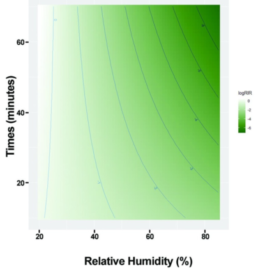Ozone and humidity:Hand in hand for better efficacy
The most important quality control feature of the STERISAFE PRO is the constant monitoring of the ozone concentration ([O3]) and the relative humidity (%RH). By following in real-time the exact levels of both those variables, one can ensure the successful completion of a given disinfection cycle. Typically, the STERISAFE PRO operates at high levels of ozone concentration and relative humidity (80 ppm and ±90 %RH, respectively). But if the ozone concentration is an obvious marker of biocidal efficacy, why is having a high humidity level so important as well?
Ozone and humidity: not a state secret
The synergistic effect between ozone and relative humidity has been documented for a long time. The first study to report that relation dates from 1942: the authors Elford and Ende found out that even a very low concentration but high humidity level, ozone had a noticeable germicidal effect on airborne microorganisms. On the other hand, at <45 %RH, no biocidal effect could be detected. This dependency was later confirmed by Guerin (1963), which concluded that ozone sterilization was only efficient on sufficiently hydrated cells; desiccated microorganisms were significantly more resistant to ozone treatment.
More recently, a 2020 study (Dubuis et al.) illustrated the dependency between relative humidity, treatment time and efficacy on the activity of airborne viruses (see Figure 1 below). At fixed ozone concentration (< 1.5 ppm), the infectious ratio of the tested microorganisms dipped down considerably with higher %RH. Inversely, in dry conditions, the infectious ratio was unchanged from untreated conditions. Logically, longer treatment times also coincided with higher loss of activity. These findings are particularly relevant in current times, where new information about the propagation of the novel coronavirus pandemic strongly suggests for airborne transmission.


Figure 1. Modelling of the ozone efficacy on two different viruses (left: Phage PR772; right: murine norovirus, MNV-1) with variable treatment time and relative humidity. The darker the color, the greater the inactivation. Source: Dubuis et., 2020
As the ozone dependency on high humidity levels has been documented for several decades, it is baffling how unscrupulous manufacturers of household ozone generators simply ignore this fact. As such, it is not uncommon to see such ozone-based products with no humidity-modifying technology advertised under vague terms suggesting for an efficient antimicrobial effect (“STERISAFE PRO, more than an ozone generator”).
Mechanism of inactivation by ozone
The reason behind the importance of humidity in ozone-based disinfection process is two-fold. First is the physical reason. Higher humidity levels allow for the rehydration of desiccated pathogens, which decrease their resistance to ozone action. Water also tends to form a thin layer around biological material such as bacteria and viruses; when talking about surface disinfection, this permits for the creation of a wider surface contact between target pathogens and ozone. This is significant for the second reason as to why humidity is such a deciding factor for ozone biocidal efficacy, as explained below.
From a chemical standpoint, and in presence of water, the destructive action of ozone can undergo two distinct pathways: either by direct action or through reaction intermediates called radical species. Because molecular ozone is so reactive, it can also react with water and form transient radical species which are extremely short-lived but highly reactive. Similar to ozone, those species exhibit high oxidative power and can in turn react with and inactivate harmful pathogens such as bacteria, virus, fungi and yeasts.
As ozone and radical species can and will react differently, pathogen inactivation via oxidative damage can occur through several mechanisms. It is generally agreed that the most common target for ozone-driven reactions is the bacterial cell wall, which is composed of unsaturated lipids amongst others. By damaging those components, ozone and radical species can cause the cell wall to crumble, leading to the targeted cell bursting (cell lysis). Another potential target for ozone and radical species is the genetic material without which bacterial and viral cells cannot survive and reproduce
Conditions of a STERISAFE PRO cycle
Due to the high relative humidity during a STERISAFE PRO cycle, end-users often voice concerns over potential damage due to condensation risks, especially on electronic components. But as droplet size is not as important as for other technologies such as hydrogen peroxide fogging, a STERISAFE PRO cycle does not introduce large water droplets in the disinfected area. As such, systematic condensation does not occur with our system. However, condensation may of course be caused by temperature differential; so it is important to identify cold spots prior to launching a cycle.
By constantly monitoring the %RH and [O3] values and ensuring that every single disinfection cycle is conducted appropriately, STERISAFE PRO guarantees the efficacy of its biocidal process. Combining high humidity levels along with ozone ensures that a suitable environment is created, where ozone will be able to start a cascade reaction which includes reactive radical species, giving ideal parameters for the complete inactivation of harmful microorganisms present in the treated room.
References
- Dubuis et al. (2020). Ozone efficacy for the control of airborne viruses: Bacteriophage and norovirus models. PLoS ONE 15 (4): e0231164
- Elford & Ende (1942). An investigation of the merits of ozone as an aerial disinfectant. Journal of Hygiene 42: 240-265
- Kim et al. (1999). Application of Ozone for Enhancing the Microbiological Safety and Quality of Foods: A Review. Journal of Food Protection 62 (9): 1071-1087
